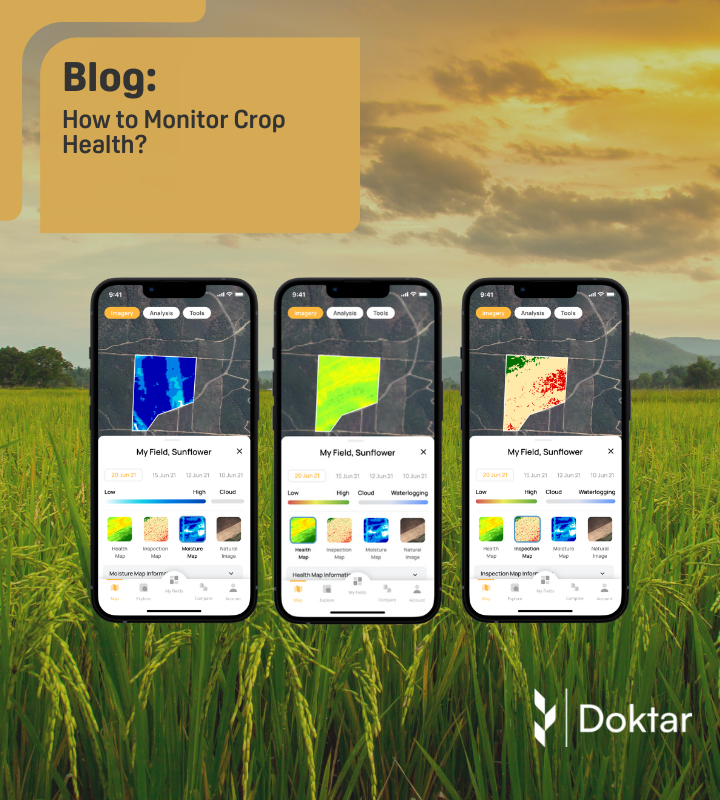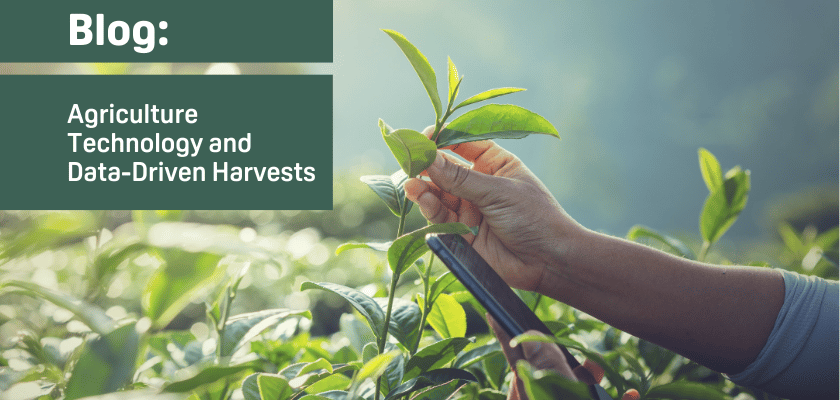

How to Monitor Crop Health?
Crop health monitoring entails leveraging various technologies to evaluate crop conditions and identify indications of stress, disease, or other concerns. It bolsters yields and fosters sustainable agricultural practices while curbing expenses through precise watering and pesticide application management. At Doktar, we are committed to pioneering advancements in agricultural technology and ensuring our products remain at the forefront of innovation.
Published on 17 April 2024
Crop health monitoring represents a dynamic and intricate domain, blending technology, scientific expertise, and hands-on farming acumen. It is a pivotal asset for contemporary farmers, empowering them to cultivate robust crops, optimize yields, and foster sustainable agricultural practices. Whether you operate a modest farm or belong to a sprawling agricultural enterprise, embracing and integrating crop health monitoring methodologies can yield substantial advantages. Adopting this strategy is not merely a stride toward enhanced farming; it signifies a significant leap toward a more prosperous and sustainable tomorrow.
What is crop health?
Crop health is a multifaceted concern influenced by a myriad of factors. Beyond the external threats posed by pests and diseases, internal challenges such as nutrient deficiencies can also significantly impact crop development and yield potential. Understanding the specific nutritional needs of crops and ensuring they receive adequate nourishment is paramount for maintaining optimal health and productivity. Additionally, environmental stressors such as extreme weather events, soil degradation, and water scarcity pose significant challenges to crop health. Drought conditions, for instance, can lead to water stress, disrupting physiological processes and diminishing yield potential. Similarly, soil erosion and nutrient depletion degrade soil fertility, further exacerbating crop vulnerability to pests and diseases. Implementing sustainable farming practices, such as soil conservation measures and efficient irrigation techniques, can help mitigate these environmental stressors and bolster crop resilience in the face of adversity.
By adopting an integrated approach to crop health management that encompasses pest and disease monitoring, nutrient management, and sustainable farming practices, farmers can proactively safeguard their crops against threats and optimize productivity in a changing agricultural landscape. Through ongoing monitoring, timely intervention, and continuous adaptation, farmers can nurture healthy crops and contribute to global food security and sustainability efforts.
How to measure crop health?
Crop health monitoring entails leveraging a range of technologies to evaluate crop conditions and identify indications of stress, disease, or other concerns. Satellite and aerial imagery offer an expansive view of fields, facilitating comprehensive surveillance. These images are examined to detect alterations in color and texture, indicative of potential issues. Furthermore, soil and plant sensors are crucial in measuring parameters like moisture levels, temperature, and nutrient levels.
Remote Sensing
Remote sensing, whether through satellite imagery or drone technology, offers farmers a powerful tool for monitoring crop health and assessing field conditions with precision. By capturing data from a distance, remote sensing enables the rapid and cost-effective assessment of large agricultural areas, facilitating timely decision-making and intervention. High-resolution satellite imagery can detect subtle changes in vegetation health and tools equipped with specialized sensors can provide detailed information on factors such as plant health, canopy structure, and soil moisture. This wealth of data empowers farmers to identify areas of concern, optimize resource allocation, and implement targeted management strategies to maximize crop productivity and sustainability.
Additionally, remote sensing minimizes disruption to field operations and reduces the need for manual data collection, saving both time and labor costs for farmers. As remote sensing technologies continue to advance, with improvements in spatial resolution, spectral capabilities, and data processing algorithms, their role in precision agriculture and crop monitoring is expected to expand, offering farmers increasingly sophisticated tools for optimizing crop health and resilience in an ever-changing environment.
GIS (Geographic Information System)
GIS technology is a powerful tool for farmers and agricultural professionals, enabling them to visualize, analyze, and manage spatial data related to crop health and field conditions. By integrating various layers of information, such as soil type, topography, weather patterns, and crop performance data, GIS software allows users to create detailed maps and conduct spatial analysis to gain insights into factors influencing crop health and productivity. GIS facilitates data-driven decision-making by providing a spatial framework for evaluating the effectiveness of management practices and optimizing resource allocation. With its ability to integrate diverse datasets and generate actionable insights, GIS plays a crucial role in modern agriculture, empowering farmers to make informed decisions and optimize crop health and yield potential.
NDVI (Normalized Difference Vegetation Index)
NDVI is a valuable tool in assessing vegetation health and monitoring crop conditions. By comparing the amount of near-infrared and visible light reflected by plants, NDVI quantifies the density and vigor of vegetation cover, offering valuable insights into crop vitality and growth patterns. This index is particularly useful for identifying areas of stress or poor health within a field, as vegetation experiencing reduced photosynthetic activity will exhibit lower NDVI values. Farmers and agronomists can use NDVI imagery to pinpoint areas requiring attention, such as nutrient deficiencies, water stress, or pest infestations, allowing for targeted intervention and management strategies. Additionally, NDVI data can be used to track changes in crop health over time, assess the effectiveness of management practices, and optimize resource allocation for improved productivity and sustainability. With its ability to provide timely and actionable information on crop health and performance, NDVI is an invaluable tool for modern agriculture, empowering stakeholders to make informed decisions and maximize yields while minimizing environmental impact. As advances in remote sensing technology continue to enhance the accuracy and accessibility of NDVI data, its application in precision agriculture and crop management is expected to expand further, driving innovation and efficiency in the agricultural sector.
What do we offer as Doktar?
A crop health monitoring system is built to help farmers identify visible diseases in the crop leaf and monitor the pest populace in the field. The goal of data collection is to limit the disease's spread throughout the field. Given that satellite images play a crucial role in following crop health, the first step is to determine field boundaries and crop types. In this, @CropMap is crucial in measuring market volume and segmentation, offering accurate predictions, optimizing your operations, and minimizing production costs.
Filiz, as an IoT sensor station, monitors physical parameters such as soil moisture, rain detection, and temperature. By turning them into insightful data, the goal is to help farmers follow crop health easily. The tailored recommendations that Filiz offers for assessing crop health, disease and frost risk, and appropriate watering cycles. Doktar’s latest innovation, FlowMeter is crucial for measuring flow rates and providing detailed irrigation reports through an easy-to-use app. Ensuring efficient water use is crucial for plants not to be affected by fungi, insects, nematodes, bacteria, and viruses.
Orbit, as a field scouting software app provides real-time crop monitoring through satellite-based remote sensing. With an easy-to-use interface, you can display your field’s NDVI values on your phone and learn about crop health. Orbit lets you manage risks and optimize production in your field. PestTrap is an IoT pest-tracking station that uses machine learning to identify and count pests in real-time. Used to attract insects with its pheromone trap lure, PestTrap optimizes crop health and yields while reducing the economic impact of pest-related crop damage.
Crop health monitoring stands as a cornerstone for bolstering yields and fostering sustainable agricultural practices while curbing expenses through precise watering and pesticide application management. At Doktar, we are committed to pioneering advancements in agricultural technology and ensuring our products remain at the forefront of innovation. To delve deeper into our company's endeavors and achievements, we invite you to connect with us on Instagram and LinkedIn. For a more personalized insight into our offerings, kindly complete the communication form. Thank you for joining us on this journey toward a more resilient and efficient agricultural future.

Agriculture Technology and Data-Driven Harvests
The convergence of agriculture technology and data-driven solutions represents the next frontier of innovation in farming. With companies like Doktar leading the way, farmers can leverage these advancements to improve productivity, reduce environmental impact, and secure a more sustainable future for agriculture. Whether through precision agriculture, sustainable agriculture, or cutting-edge smart agriculture technology, the future of farming is bright, and data is at the heart of this transformation. Technology's positive impact on this future should inspire and motivate us all.

Integrating Crop Health Monitoring Systems for Better Farm Management
Crop health monitoring systems revolutionize modern agriculture by enabling real-time insights into plant health, reducing losses, and promoting sustainability. Tools like Doktar’s CropMap and Orbit integrate advanced technologies, empowering farmers with data-driven decisions. By enhancing efficiency and sustainability, these systems are essential for future-proofing agricultural operations.

Modern Agriculture: Innovative Solutions to Combat Global Food Insecurity
Modern agriculture combats global food insecurity with precision agriculture, sustainable practices, and biotechnology. Tools like IoT, automation, and crop innovations optimize resource use, enhance resilience, and ensure stable food supplies. By integrating smart technologies, agribusinesses address challenges like climate change and resource scarcity, paving the way for a sustainable food future.
